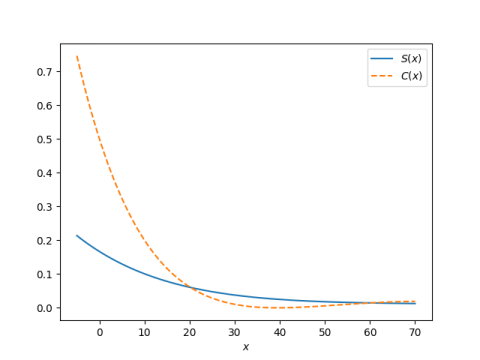S and C functions
I was reading a book on orbital mechanics recently [1], and one of the things that stood out was the use of two variations on sine and cosine, functions the book denotes by S and C.
Strictly speaking, the functions are defined to be the analytic continuation of the middle expressions to the full complex plane, and these continuations have the given power series.
These functions come up in deriving time of flight equations. The direct derivation has expressions that would have a singularity at zero because of square root terms, and recasting the solution in terms of the functions above avoids the singularities.
(Are these functions used outside of orbital mechanics? Do they have names other than S and C? If you've seen them before, please let me know.)
I find these functions interesting for several reasons. First, it's interesting that the power series for the two functions are so similar.
Second, the functions S and C are derived from sine and cosine, but you might not guess that from looking at their plots.

The power series forms of the two functions are similar, but the plots of the two functions are not.
Third, you might expect the derivative of a sine-like thing to be a cosine-like thing and vice versa. Well, that's sorta true in our case. The derivatives of S and C are related to the functions S and C, but its a little complicated.
Maybe it's surprising that the relationship is as complicated as it is, or maybe it's surprising that it's not more complicated.
Finally, when z is a real variable, we can evaluate S with
and evaluate C with
Written this way, it looks like the functions S and C are arbitrarily patched together. But the functions are smooth at 0, even analytic at 0 as the power series shows. The equations are not arbitrary at all but uniquely determined.
Update: Someone contributed this post to Hacker News and someone else left a helpful comment with some historical background. Apparently this work goes back to Karl Stumpff and was written up in a NASA technical report. It was further developed at MIT and written up in a textbook by Richard Battin.
More orbital mechanics posts[1] Fundamentals of Astrodynamics by Roger R Bate, Donald D. Mueller, and Jerry E. White. Dover, 1971.
The post S and C functions first appeared on John D. Cook.